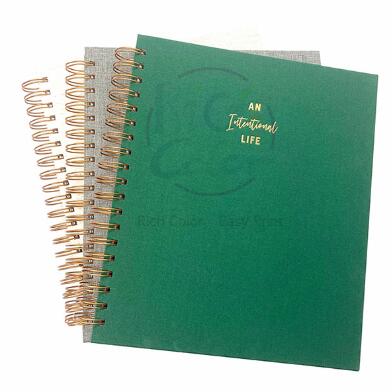Understanding the Environmental Impact of Cloth Daily Planners
2024-12-25
Daily planners have become essential tools for organizing tasks and staying productive. However, their environmental impact depends heavily on the materials used in their production. In this blog, we explore the environmental implications of using cloth for daily planners compared to leather and paper alternatives.
The Case for Cloth Materials
Cloth is a versatile material that has been gaining popularity for daily planner covers. Here are some reasons why it’s considered environmentally favorable:
1. Renewable Resource: Many cloth materials, such as cotton or linen, are derived from renewable resources. These can be sustainably farmed, especially when sourced from organic or certified farms.
2. Recyclability: Unlike synthetic materials, natural fabrics can be recycled or composted, reducing their end-of-life impact.
3. Low Carbon Footprint (Potentially): Depending on the manufacturing process, cloth can have a lower carbon footprint compared to leather or plastic-based materials.
Comparing Cloth, Leather, and Paper
To assess the environmental impact, let’s compare these three popular materials:
- Cloth: While renewable and biodegradable, the environmental friendliness of cloth depends on factors such as farming practices, water usage, and dyeing processes. For instance, conventional cotton is water-intensive and uses pesticides, whereas organic cotton has a smaller environmental footprint.
- Leather: Leather is durable but raises significant ethical and environmental concerns. The tanning process involves harmful chemicals, and the livestock industry contributes to greenhouse gas emissions. Faux leather—a synthetic alternative—has its own drawbacks due to reliance on fossil fuels.
- Paper: Paper planners are biodegradable and recyclable, but their production contributes to deforestation unless sourced from recycled or certified sustainable materials. Laminated paper or those with synthetic coatings are less eco-friendly.
Is Cloth Printing Sustainable?
Printing on cloth can be sustainable when eco-friendly inks and energy-efficient processes are used. Digital printing methods often require less water and produce less waste compared to traditional screen printing. Additionally, using water-based or plant-based inks reduces harmful emissions.
Cloth daily planners can be a sustainable choice, particularly when natural and ethically sourced fabrics are paired with eco-friendly printing methods. However, the overall impact depends on the specifics of the production process, making it essential for consumers to research and choose planners made with sustainability in mind.



